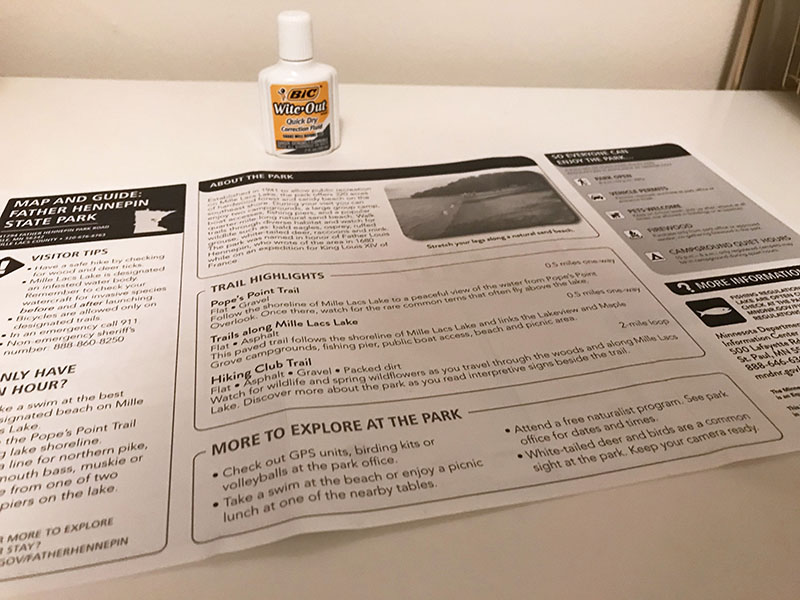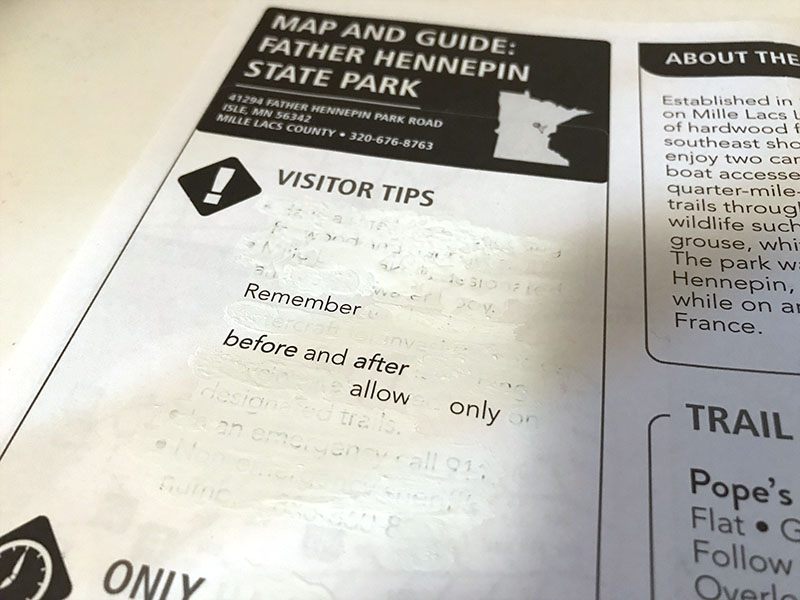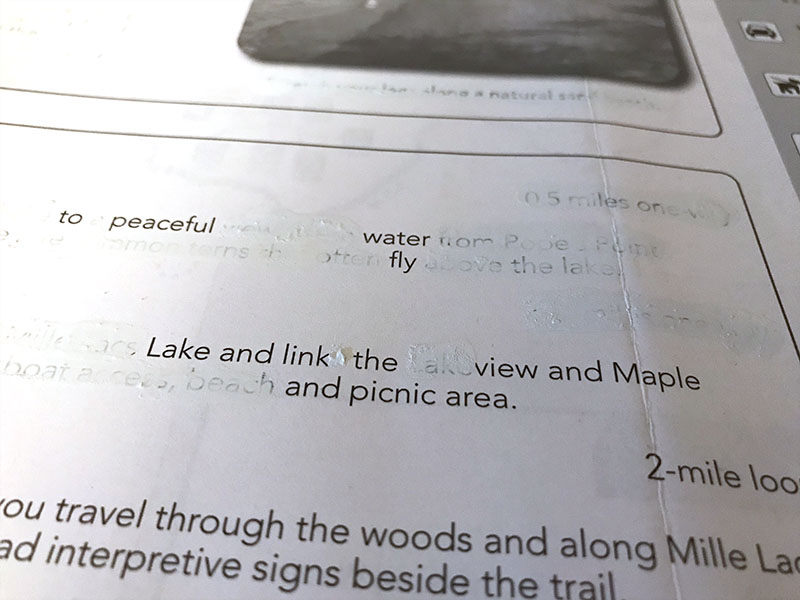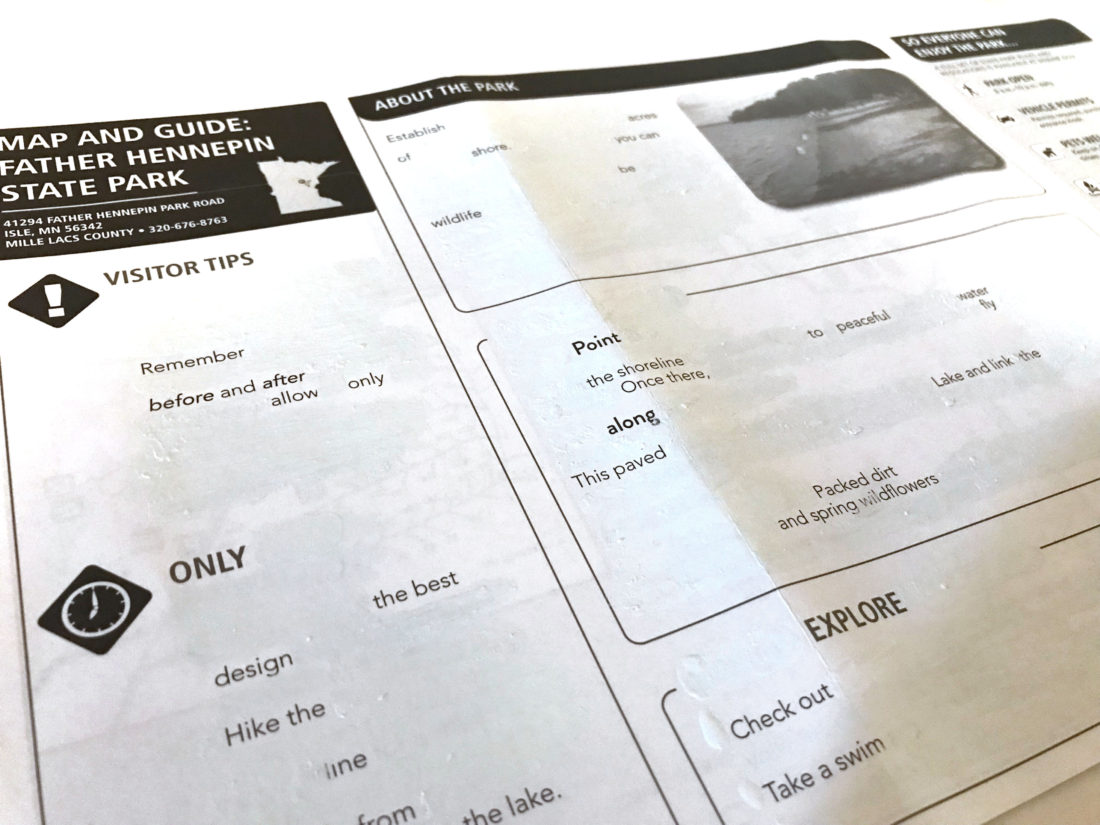If standard poetry is like watercolors, then erasure poetry is like sculpting.
Erasure poetry is a really fun and challenging form of poetry in which you create a poem by erasing or removing words from any kind of existing text. The remaining words are what make up your lines and stanzas.
It challenges you to find poetry in the world around you, and to create something with limited resources – the words in front of you.
You can go about creating erasure poetry in a variety of ways, and can use anything that has words on it.
When I visited my 25th State Park, Father Hennepin State Park, I grabbed an extra map, because I knew I wanted to create an erasure poem with it. The symmetry of it being the 25th State Park on my 25 Things list was not lost on me, and I thought I’d celebrate the milestone with some poetry.
Here are my tips on how to write an erasure poem, followed by the poem I created:
1. Gather your materials
The first step is to find a piece of text – it can be anything: a torn out book page, a magazine, a map, a menu, brochures or pamphlets, an instruction manual, you could even print out this webpage and use it! The list could go on and on, because you could truly use anything with text on it.

Next you’ll need some Wite-Out. This could also be changed up, depending on what your vision is. You could use paint if you wanted to add some color to your pages, or if you selected a piece of text printed on colored paper, you could try to match that color to truly erase the words. It’s all up to your preference, and what you’d like your poem to look like, but I typically stick with Wite-Out.
2. Start by erasing words you don’t like
It’s like cleansing your palette.
Sometimes it can be daunting, staring at a full piece of text, and wondering where to start eliminating words to shape your poem. If I don’t immediately see a line I want to carve out, I begin by erasing words that I don’t like, so I can focus on the words that I do like, and know that I want to use.

Here, I started by erasing the words “tick,” “infested,” and “invasive species.” Not words that jived with me.
If you know you’re not going to use them anyway, you might as well erase them right out of the gate! I find it easier to focus on the words I do like, and to find poetic lines within the paragraphs once I’ve eliminated words that I dislike, or that don’t feel fitting.
The way “before” and “after” were bolded and italicized struck me as cool, so I knew that I wanted to keep them for sure. I also knew I didn’t want to keep the emergency information, so once I carved out those words, it was easier to see where I wanted to take the first line.

Start by reading through your paragraph or the first line of text, and decide which words you don’t like and want to erase.
3. Alternatively, try picking out the words that you do like
Sometimes it can help to identify the words that you do like – sometimes you can string them together to create a line on the spot, using other words to fill in the blanks.

Here I liked the words “Point,” “shoreline,” “peaceful,” and “water,” so I kept them, and used “the” and “to” to create a complete sentence. I then erased all of the words that didn’t make up that sentence.
4. Break sentences up into new ones
Mold your lines. Once you’ve started identifying words you do or don’t like, go crazy! Break up sentences, carve out words, make up poetic lines by using a variety of words from different sentences.
Sometimes it could take a whole paragraph, or even a few paragraphs, to create one line in your poem. In the image above, I was averaging about one line per paragraph, so don’t limit yourself when creating your lines.
5. Follow your instincts
I split up my erasure poetry into pieces, so I’ll take the text paragraph-by-paragraph, and create lines one paragraph at a time. I begin each section by reading through the paragraph a few times, and absorbing the words within it. Sometimes, as I’m doing so, a line will immediately jump out at me, and I will erase the extra words around it. I don’t need to identify the words I do or don’t like, because I already know what line I want to create. If you’re struck by something like that, follow your gut and get rid of the extra words!

The words “Hike the line” stood out to me when I first read through the paragraph, so I kept them and carved out the sentence from amongst the other words.
6. Keep conjunctions and prepositions until you know you don’t need them
There’s nothing worse than trimming down a paragraph and erasing words, only to realize you need a “the” or “and” to complete your sentence, but you’ve already erased it.
While erasing words like “tick” or “infested” can help you focus, let our conjunction and preposition friends stick around a bit until you know that you won’t use them in your poem. It’s nice to have options to link your words.
7. Don’t be afraid to make new words out of old ones
Part of the fun of this style of poetry is erasing old sentences and making new ones. Why not do the same with words? It adds a challenge if you see every word as a possibility for something new, and it makes you pull out your creativity even more.

Here, I made the word “view” out of “Lakeview,” which is a pretty easy word to split up. Compound words are easier to break up, but you could do this with a plethora of words! Sometimes you can even get conjunctions or prepositions out of existing words.
8. Once you’ve created your poem, give it another coat or two
Or don’t. It’s up to you.
I like to go over my poem with another coat of Wite-Out, because I like to truly erase the excess words, so the words I have selected for my poem jump right out at you. However, maybe you want some words to be slightly visible through a thin layer of Wite-Out. Maybe you want to create a secondary poem in the Wite-Out shadows of your first. Maybe you just like the look of the half-erased words.

Do whatever feels right, or looks the way you’d like your poem to appear! It’s all up to your preference.
The finished product
After all that erasing and poetic sculpting, here is what I was left with!

Visitor Tips
Remember –
before and after –
allow only,
only,
the best design.
Hike the line
from the lake.
Look.
Explore.
Visit.
Establish acres
of shore.
You can be
wildlife.
Point the shoreline
to peaceful water.
Once there,
fly along this paved lake and link
the packed dirt and spring wildflowers
along the trail.
Explore.
Check out.
Take a swim.
See for sight.
Keep your camera ready.
Want to read more about my 25 Things list? Click here for more adventures.
Let’s Connect:




How falles it then, that with so smooth an ease My thoughts I speake, and what I speake doth flow In verse, and that my verse best wits doth please?